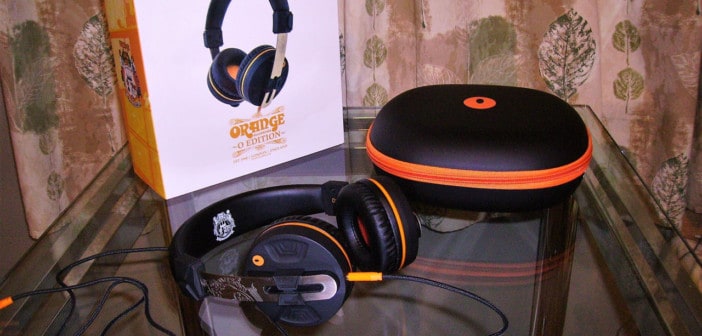Since 1968, Orange Music Electronic Company has earned the respect of guitarists everywhere, manufacturing quality guitar amplifiers for almost fifty years. Orange is now venturing out into the “wearables” market with their new ‘O’ Edition Headphones, an on-ear design with a neutral EQ response and a solid build that reflects the durability of their amplifier line.
The Review
Before I get too far ahead of myself, I just want to call attention to the packaging. When my O Edition Headphones arrived in the mail, I was surprised by the sturdiness and overall attractiveness of the box, which is actually so nice it belongs on display. There’s even a magnetic flap inside the lid that folds open to reveal the product specifications and documentation printed therein.
The headphones are enclosed in a small, lightweight clamshell case, along with a braided 3.5mm cable with a remote control and a built-in microphone compatible with most smartphones. There are also two extra braided cables, one with only a playback control button and the other without any controls; all of which are detachable, and can be stowed in a small mesh pouch within the case.
The headphones themselves are also quite beautiful, with an elegant black & orange aesthetic and the Orange Company Crest laser-etched into both sides of the brushed stainless steel ear cup attachments. Unfortunately, there are no swivel joints for each ear cup; of course, a design like this one doesn’t really call for anything like that. The headphones are, for the most part, very comfortable.
These are marketed as on-ear headphones, but I think they qualify as over-ear headphones with ear pads just big enough for your ears to slip into, but not quite big enough for your ears to be comfortable inside of, at least not for long! That said, I personally prefer over-ear headphones whereas others prefer on-ear designs so my experience may not be your own. Regardless, I’ve actually become less and less bothered by the whole on-ear thing the longer I wear them, so it’s no dealbreaker.
As for how they sound, I am very happy to say that the flat response is delightfully transparent, even though there seems to be a slight bump in the low-mid frequency range. I can’t be too certain since I have not properly tested the frequency response through a spectral analyzer, but if my ears are any indication, the midrange is a bit beefier than what I’m used to. However, even if this is true, I quite enjoy the result. In fact, for mastering purposes, I could really use some headphones that ever so slightly nudge the low-mid frequency domain to the fore, especially when working with basslines.
Speaking of bass, I’d like to reassure anyone who might be overly concerned with the frequency response of 20Hz – 20kHz in light of other headphone manufacturers that boast 10Hz – 20kHz. The human ear cannot register anything below 20Hz; even though frequencies below 20Hz can be felt as vibrations in large speaker systems, it doesn’t make very much sense for headphones, so don’t fall for the 10Hz hype. I’m very satisfied by the tight low end of these O Edition headphones.
The Verdict
While I’m not especially thrilled with the on-ear design, which I’m still getting used to, there’s no denying that these are absolutely fantastic headphones, and I’m very happy to have them within reach. Orange has made a big statement with their first foray into the headphone market. Sure, there’s still room for improvement, but if they plan to continue down this road, this a great big step in the right direction.
More info: Orange ‘O’ Edition Headphones (€166)
Orange 'O' Edition Headphones Review
-
Sound Quality10
-
Build Quality10
-
Design7
-
Price8



2 Comments
Adam Bialy
onI have to disagree on one thing – wich is frequency response . Sure human ear cannot register anything below 20 Hz and even have big problem to place in spectrum anything below 150 Hz – that’s the physics , but those 10 Hz of advertised low end in headphones is real range of cut smoothness . I tells us that hearable by all testing devices cut curve starts at that low 10Hz so full range of volume at 20 Hz is close or (in best scenario) direct on “0” dBFs. So the more lower range of frequency response in cans you have – the more actuall cut will be hearable.
Bryan Lake
on…………………………………………………………………………………………………Right.